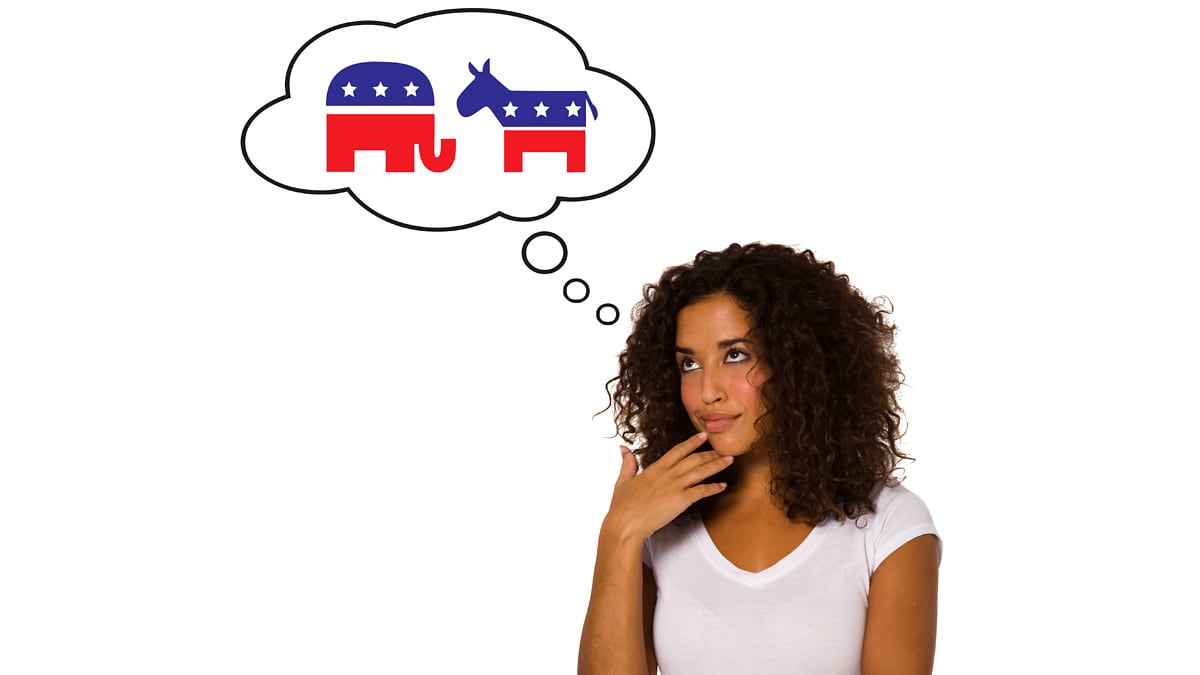In the final stretch of this play-to-the-base presidential election, it is strange to say that the 40 percent of Americans who identify as independent are currently close to an afterthought. With so few undecided voters left, even most independents have chosen sides by now.

But some day this election is going to end, and if the next president and the next Congress hope to break through the hyperpartisan stalemate, they are going to have to find ways to appeal to the largest and fastest-growing segment of the American electorate.
Two timely new books—Mickey Edwards's The Parties Versus the People: How to Turn Republicans and Democrats Into Americans and Jacqueline Salit’s Independents Rising offer valuable insights into the impulses that have inspired a record number of Americans to reject the two parties and demand something different.
The two authors come to some of the same conclusions from very different perspectives. Edwards is a former Republican congressman from Oklahoma, a member of party leadership during the Reagan era and now a vice president of the Aspen Institute. Salit is a New York City–based campaign strategist, third-party founder, and political activist who was raised part of the professional left and now runs IndependentVoting.org. Their two books reflect their very different personal experiences in politics, but they identify some of the same problems and solutions.
Edwards’s book takes a decidedly more national perspective, reflecting his congressional career and understanding of the way Washington really works. It makes his prescriptions particularly powerful because they are practicable, if not a little ambitious.
The Parties Versus the People: How to Turn Republicans and Democrats Into Americans is an urgent and engaging look at how American politics have become the founding fathers’ worst nightmare. Not content to simply criticize, Edwards also proposes solutions to the hyperpartisanship currently corroding civil discourse and resulting in the paralysis of Congress, a serious threat to the American experiment in self-governance.
Balancing stories from different eras in American politics with his own experience as a member of Congress, Edwards makes a compelling case that the current congressional division and dysfunction is the result of an incentive structure run amok. Procedural rules and election laws have been rigged to reward hyperpartisanship, thereby trapping otherwise well-intentioned people in a system that rewards intransigence, treating members of the other party as the enemy.
Edwards details prescriptions for each of these problems: primarily election reform, including open primaries and redistricting reform and congressional reform, including filibuster reform. (Some of these proposals dovetail with suggestions made in the “Making Congress Work” plan developed by No Labels, a group Edwards and I helped cofound with fellow Daily Beast columnist Mark McKinnon and Nancy Jacobson). Edwards also proposes ways to reduce the amount of money in politics, such as limiting congressional contributions to that which can be raised from a congressman’s constituents and requiring a percentage of free advertising time be given to candidates in exchange for private entities’ lease of public airwaves.
Perhaps most daring, he makes a case for selecting the speaker of the House on something more than purely party lines, as a way of pushing back on the increasing parliamentary impulses of our Congress. The Constitution, Edwards points out, does not even require the speaker of the House to be a member of Congress. Moreover, he points out that in England, the speaker of the House of Commons is a decidedly nonpartisan figure. He therefore suggests that one solution would be to require that more than a narrow majority of members of Congress vote in favor the speaker of the House on secret ballot. This means that whoever is put forward would have to have some degree of mutual respect rather than being among the most polarizing partisan members of the body (think Newt Gingrich and Nancy Pelosi). This is both a disruptive and a constructive idea.
Edwards’s offering is a rational rallying cry for the moderate majority of Americans concerned that Congress’s division and dysfunction is hurting our ability to self-govern in the national interest. “If the game of government rewards intransigence and punishes compromise, we shouldn’t be surprised if we get a lot of intransigence and not much compromise,” Edwards writes. “If our government continues to fail us—and it will—then we need to change the incentives, change the architecture of the field on which we play.” The Parties Versus the People is an important—and I believe, enduring—addition to the growing literature of nonpartisan political reform.

Independents Rising is a street-level look at the grassroots activism of independent politics, propelling the creation of the New York Independence Party (described as an “anti-party party”) and electing New York City’s independent Mayor Mike Bloomberg. Salit’s book is more of a memoir, a look at the rise of independent politics largely through the prism of her own life.
Salit offers new insights into the independent reform movement that gave birth to Ross Perot’s 1992 and 1996 presidential campaigns. She also details the backroom debates and odd political bedfellows that its successor, the Reform Party, later backed for president with a high degree of ideological whiplash: Pat Buchanan and Ralph Nader. Accordingly, Salit strenuously objects to the term “centrist” and decides instead to focus on the political diversity that exists beneath the modern independent movement (and, of course, any political demographic that includes 40 percent of the American people would be largely representative of the overall American electorate and therefore decidedly diverse, especially when activists are taken into account.)
Salit’s admittedly New York–centric perspective is not representative of the entire independent movement, but she has unique practice stitching together broad coalitions united in the effort to enact election reforms, aiming to upend the political duopoly. Personally loyal to her partners, Dr. Fred Newman and Dr. Lenora Fulani, she places these nationally obscure personalities at the center of her independent movement narrative overall, only delicately discussing their frequently toxic politics, which include sometime embrace of Marxism, anti-Israeli rhetoric, and post-9/11 apologies for American foreign policy. These positions are not remotely representative of the vast majority of independent voters, who polls show have political views more in line with Americans overall than members of the increasingly polarized Republican or Democratic parties.

But there is no dismissing the pivotal role that Salit’s Independence Party line provided in electing Mike Bloomberg the mayor of New York in 2001. The 55,000 votes he received on the Independence line accounted for his razor-thin margin 35,000-vote victory over Democratic Party standard-bearer Mark Green. This concrete fusion victory provides ballast for the political theory discussed in much of the book, and it remains an important example of how third parties can help create new coalitions that upend status-quo assumptions.
The most broadly valuable chapter of Independents Rising is titled, ironically, “The Parties Versus the People.” It details independent politics and election-reform efforts in a number of states, including California, Kentucky, and Idaho, chronicling the court cases and ballot initiatives that are the frontlines of the fight to open up the political process to perspectives outside the two parties. Many of the court cases feature the work of election lawyer Harry Kresky, who has distinguished himself as a leading legal advocate for local election reform. In the process, readers get to meet outsize independent political personalities, like Kentucky’s Michael Lewis, and gain insight into the court wrangling that accompanied the passage of California’s new nonpartisan top-two primary system and its new independent redistricting system, both of which were strenuously opposed by the two parties who sought to keep the status quo in place by almost any means necessary. In the process, readers also gain new insight into better-known national political reformers, from Mayor Bloomberg to former California governor Arnold Schwarzenegger, who have backed these efforts. The reader leaves with a better sense of the firmament and frontline fights occurring in the current independent movement.
The Parties Versus the People and Independents Rising stand alongside the best political policy books of this presidential season, like Norm Ornstein and Thomas Mann’s essential It’s Even Worse Than It Looks, Linda Killian’s incisive The Swing Vote: The Untapped Power of Independents, and Jonathan Haidt’s sweeping The Righteous Mind: Why Good People Are Divided by Politics and Religion.
The growing ranks of nonpartisan-political-reform literature will only become more valuable when this election is over and we begin focusing on an even more urgent mission: how to heal hyperpartisanship and begin governing again in the national interest.






